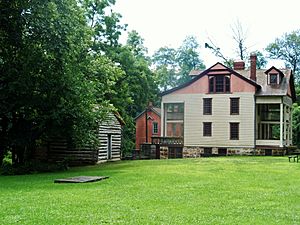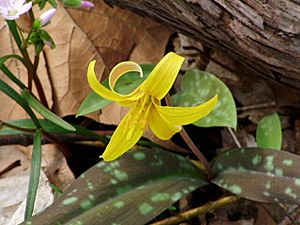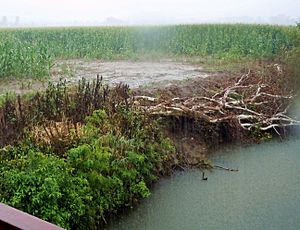East Arm Little Calumet River facts for kids
Quick facts for kids East Arm Little Calumet River |
|
|---|---|
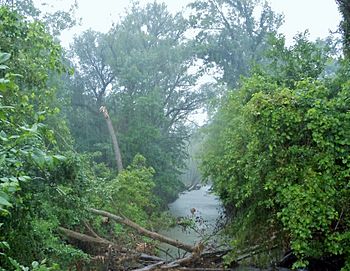
Looking west (downstream) towards the Heron Rookery from 600 East in Pines Township.
|
|
| Other name(s) | Little Calumet River East Branch |
| Country | United States |
| State | Indiana |
| Region | Porter County, Indiana |
| Cities | Chesterton, Porter, Burns Harbor |
| Physical characteristics | |
| Main source | New Durham Township, LaPorte County, Indiana, United States 770 ft (230 m) 41°36′15″N 086°51′25″W / 41.60417°N 86.85694°W |
| River mouth | Port of Indiana-Burns Waterway Burns Harbor, Porter County, Indiana 584 ft (178 m) 41°36′48″N 087°10′31″W / 41.61333°N 87.17528°W |
| Basin features | |
| Tributaries |
|
The East Arm Little Calumet River, also known as the Little Calumet River East Branch, is a 22.1-mile (35.6 km) long river in Indiana. It starts in LaPorte County and flows west into Porter County. This part of the river eventually reaches Lake Michigan through the Port of Indiana-Burns Waterway.
Contents
River's Past: A Look at the East Arm Little Calumet River's History
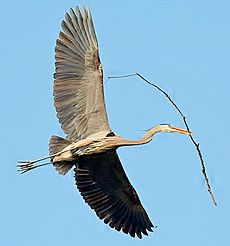
The name "Calumet" likely comes from words related to reeds or still water. It might be from the Old French word chalemel, meaning reeds. Or it could be from the Potawatomi word gekelemuk, which means "a low body of deep still water."
In 1822, a man named Joseph Bailly started a homestead and fur trading business. This place, the Joseph Bailly Homestead, is now part of Indiana Dunes National Park. It is located on the east bank of the Little Calumet River in Porter, Indiana.
The Potawatomi people would bring beaver furs by canoe to Bailly. He then shipped these furs to Mackinac, which were then traded to Montreal and Europe. By 1830, most of the beavers were gone. Bailly then opened a tavern on the road from Fort Dearborn to Detroit. This marked the end of the fur trading time in northwestern Indiana.
Before 1926, the river continued west into Illinois. But then the Burns Waterway was dug. This changed the river's flow. Now, the East Arm of the Little Calumet River goes directly into Lake Michigan at Burns Harbor, Indiana.
River's Path: Where the East Arm Little Calumet River Flows
The East Arm of the Little Calumet River flows west under the Indiana Toll Road. It then enters Round Lake near Holmesville. Along its journey, other smaller streams join it.
- Carver Ditch joins from the right.
- Reynolds Creek, Sand Creek, Coffee Creek, and Salt Creek join from the left.
- The Little Calumet River (west arm) also joins.
Finally, the river exits through the Burns Waterway into Lake Michigan.
River's Starting Point: The Valparaiso Moraine
The river's watershed, which is the area of land where water drains into the river, starts in a place called the Valparaiso Morainal Area. The Valparaiso Moraine is a curved ridge of hills. It runs along the southern shore of Lake Michigan.
This moraine divides LaPorte and Porter County. Water north of the moraine flows into Lake Michigan. Water south of the moraine flows into the Kankakee River. Many small lakes, called kettle lakes, are found on the moraine.
Wildlife and Nature Along the East Arm Little Calumet River
The river is home to many animals and plants. A special place called a rookery was protected in 1980. It became part of the Indiana Dunes National Park. This rookery is a nesting area for great blue herons (Ardea herodias).
Herons have lived in the wet woods along the river for over 60 years. In 2001, there were 98 nesting pairs. These birds fly south for winter and return to the region in spring.
Beavers: Nature's Engineers
Beavers (Castor canadensis) were once hunted a lot for their fur. They disappeared from Indiana in the 1800s. But in 1935, beavers from Wisconsin and Michigan were brought back. They were seen again in the Indiana Dunes National Lakeshore starting in 1968.
Beavers build dams that create wetlands. These wetlands help clean the water by removing dirt and harmful things. They also create good places for fish to live and grow. Beaver ponds can help fish like coho salmon (Oncorhynchus kisutch) by providing safe places for them. Most beaver dams do not stop fish from moving up and down the river.
Other Animals
The northern water snake (Nerodia sipedon) lives in the river. This snake is not venomous. It often spends winter in the rocks near bridges. You might see it near Bailly's Homestead.
In 2015, a plan was made to manage the East Arm Little Calumet River watershed. This plan was created with help from groups like Save the Dunes.
Protecting the River: Pollution and Conservation Efforts
Parts of the lower river and its Salt Creek branch are now protected. They are part of the Indiana Dunes National Park. The Heron Rookery protects a middle section of the river.
A part of the river's source, including Round Lake, is also protected. This area is called the Little Calumet Headwaters Nature Preserve. It is part of the 160-acre Red Mill County Park, which started in 2002.
The East Arm Little Calumet River watershed has some pollution concerns. It is listed as "impaired" for certain issues. This means there are warnings about mercury and PCB levels in fish. There are also concerns about pathogens, which are tiny germs that can cause sickness.
Fun on the River: Recreation and Fishing
The lower part of the Little Calumet River is a popular spot for fishing. The Indiana Department of Natural Resources stocks the river with fish.
- Steelhead trout (Oncorhynchus mykiss)
- Chinook salmon (Oncorhynchus tshawytscha)
- Coho salmon (Oncorhynchus kisutch)
These fish are not originally from this area. They swim up from Lake Michigan into the creeks where they were placed. They try to lay eggs, but Indiana's creeks are usually too warm for them to reproduce well. So, new fish are regularly added to the river.


